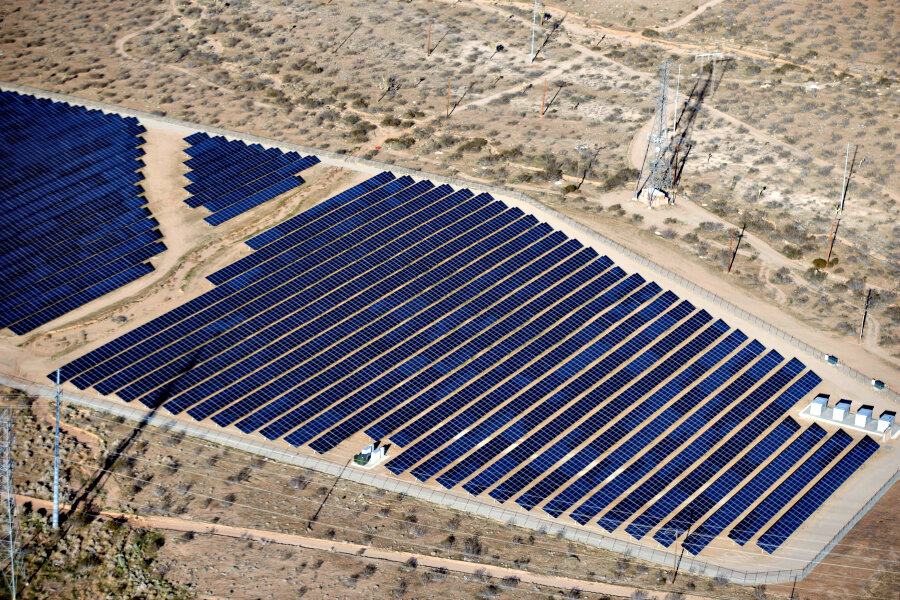Including the poor in the solar energy boom
Loading...
Thanks to net metering — a practice that lets homeowners sell to utilities excess electricity generated by solar panels — Americans in more than 45 states enjoy cheaper and carbon-free power.
Yet one group has missed out on the solar bonanza: low-income families, who are more likely to rent or live in multifamily housing where net metering isn’t available.
But just as community gardens allow people without backyards to grow healthy food, the United States’ first utility-built community solar farm hopes to plug the roofless into the green-energy boom.
Colorado’s Grand Valley Power last week broke ground on a photovoltaic power plant in Grand Junction, a mainly rural, low-income area. Residents will be able to buy electricity generated by the 25-kilowatt solar system, saving an estimated $50 to $75 on their monthly utility bill.
The solar farm is likely to be the first of many if state legislation encouraging their construction is approved.
“This is different than the other community solar models that exist,” said Kristina Sickles, Colorado development director for GRID Alternatives, a nonprofit that worked with Grand Valley Power on the project. “Many are put together by a for-profit solar developer owned by a larger financing firm.”
For Grand Junction resident Brenda Lange, a disabled 58-year-old living on a limited income, that means she and partner Herb Sanders, 62, will be able to save money on their energy bill when the solar farm goes online later this year — with no money down.
Lange had looked into going solar as a way to cut the couple’s expenses but discovered that installing a photovoltaic system was too expensive.
“Every month our energy bill seemed like it was getting higher, and when you live on a fixed income, you can’t have that,” she said. “It’s a good thing for the community, it’s great to produce a cleaner alternative for energy, and it’s helping us out financially.”
The 25-kilowatt solar farm will generate enough energy to serve six to 10 families. Those subscribers are still being selected, Sickles said, based on demonstrated need.
Each family must pay a $30 monthly fee to access the grid. They also pay two cents per kilowatt-hour for the amount of electricity consumed, which is a steal compared to the 11 cents per kilowatt-hour Grand Valley Power normally charges.
Each family will sign a four-year contract, which is renewable if they continue to qualify for the program.
Tom Walch, Grand Valley Power’s general manager, said that the utility, which operates as a cooperative, wanted to take on the project because it’s focused on providing services — not profits — to its member owners.
“We operate at the lowest costs we can,” he stated. “We have to earn a margin to keep our members satisfied, but the margins we earn are allocated to members based on their patronage.”
To keep costs down, GRID Alternatives negotiated agreements with SunEdison, Enphase Energy, and IronRidge to supply solar panels and other components at a discount. Local organizations Atlasta Solar and Alpine Bank made donations to the project.
Walch says that several other local electricity cooperatives have approached him with interest in emulating the model.
A bill now before the Colorado legislature could encourage the spread of community solar farms by letting utilities count them toward a mandate that they obtain 30 percent of their electricity from renewable sources by 2020.
In the true barn-raising model, GRID Alternatives and local nonprofit Housing Resources of Western Colorado are gathering local community members to help finish construction of the solar farm.
“Herb and I will be there,” Lange said. “We may not be able to get up on the roof, but we’ll be helping out in some other way.”
• Kristine Wong is a regular contributor to TakePart and a multimedia journalist who reports on energy, the environment, sustainable business, and food.
• This article originally appeared at TakePart, a leading source of socially relevant news, features, opinion, entertainment, and information – all focused on the issues that shape our lives. Visit takepart.com/start-from-the-source.
Related Stories on TakePart
We Pay Way Too Little for Energy Once Everything Is Added Up
Find Out if You Live in the Best—or Worst—State for Electric Cars







